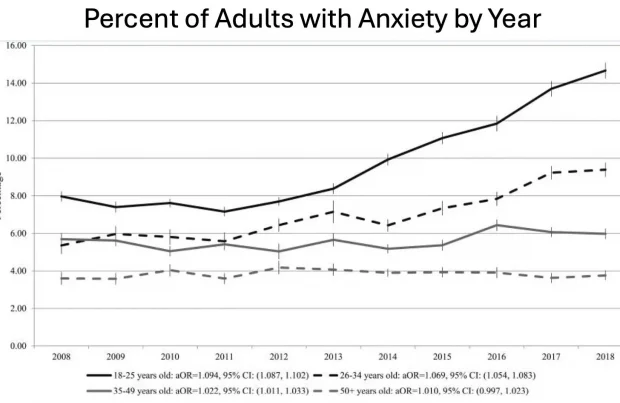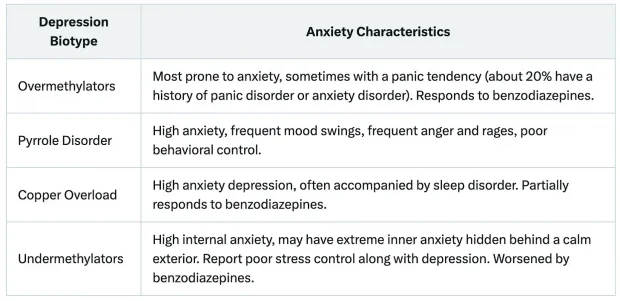Many consider anxiety to be the disease of the modern age. It is thus one of the most significant disease markets in America (e.g., from 2001-2004, approximately 19.1% of American adults had an anxiety disorder and in 2007, 36.8 billion was spent on medical care for anxiety and mood disorders). Yet despite spending billions on anxiety, rather than be appropriately addressed (like many other industries that depend upon the perpetuation of the problem they “solve”), it has only increased.
Worse still, a recent survey found slightly over half of young adults (18-26) now suffer from anxiety, 43% have panic attacks, a third take anxiety medications, 54% found they became worse in 2023, and 26% of them were diagnosed with a new mental health condition due to COVID-19.
All of this suggests we may not be utilizing the best approach to deal with anxiety—particularly since the drugs used to treat it are some of the most problematic ones on the market.
Insufficient Treatment Time
One of the biggest challenges in psychiatric care is the lack of time spent with patients. This rushed approach leads to some serious issues such as:
- There isn’t time to warn patients about significant drug side effects.
- Patients don’t feel safe reporting important side effects, like SSRI sexual dysfunction and medications aren’t adjusted properly.
- Medications end up replacing more time-intensive therapies that are far more effective in the long run.
- Most of the true healing a psychiatrist can provide requires them to be fully present to patients for a prolonged period of time.
Sadly, in today’s healthcare system, unless you work with a holistic cash-pay psychiatrist appointments are typically limited to just 15 minutes, leaving little room for meaningful interaction.
Overlapping Syndromes
A major challenge in medical diagnosis is that the same disease can create different symptoms in different patients, while completely different diseases can present with fairly similar symptoms. Because of this, it is typically much easier (and profitable) to give therapies that are directed at the symptomatic expressions of disease rather than taking the time to determine exactly what is causing the illness to trigger, and treating the root cause.
As such, one of the most common reasons individuals seek out the (often costly) realm of non-insurance covered integrative medicine is due to the fact that the symptomatic management conventional care offers leads to unacceptable outcomes (e.g., many debilitating symptoms remaining, costly and harmful “treatments” needing to be done indefinitely, or the illness progressing).
In an article on the depression industry, I highlighted a major problem with the condition—rather than there being one type of depression, numerous different things can cause it. This is often quite consequential, as while some types of depression respond well to SSRI antidepressants, others do not, and some become significantly worse with antidepressant therapy. As such, it is not appropriate to quickly diagnose someone with depression and then prescribe an antidepressant—but this is unfortunately what frequently happens, particularly in 10 minute primary care visits.
In turn, the exact same is true for “anxiety” (which helps to explain why “anxiety” and “depression” remain the two most common psychiatric diagnoses).
Types of Anxiety
Some of the most common types of anxiety include:
- Generalized Anxiety Disorder (GAD): Characterized by excessive worry about various topics greatly out of proportion to the actual issue, often with physical symptoms like muscle tension, and affects about 3.1% of the U.S. population, with a higher prevalence in women. It responds to Cognitive Behavioral Therapy (CBT) but is significantly worsened by benzodiazepines.
- Panic Disorder: In the last year, roughly 2-3% of Americans experienced sudden, unexpected, and recurrent panic attacks with symptoms like heart palpitations and dizziness. Psychotherapy, especially Exposure and Response Prevention (ERP), is effective, and in certain cases (discussed here), benzodiazepines can help panic disorders.
- Specific Phobias: Roughly 7-9% of people at some point in their life will have an irrational fear of a specific object, situation, or activity, such as heights, spiders, or flying, and experience panic symptoms when exposed to it. Like panic disorders, this condition responds to appropriate benzodiazepine use& and ERP therapy.
- Social Anxiety Disorder (SAD): Intense fear of being judged in social situations, leading to avoidance (which 7-13% of people will experience at some point in their lives). ERP therapy and low-dose beta-blockers are helpful treatments.
- Agoraphobia: About 1-2% of people fear being in situations where escape might be difficult if anxiety or panic strikes. Agoraphobia responds well to ERP therapy but not to benzodiazepines.
- Obsessive-Compulsive Disorder (OCD): Involves intrusive thoughts and repetitive behaviors. Does not respond well to CBT or benzodiazepines but can benefit from ERP therapy. SSRIs may be used by psychiatrists for treatment.
- Post-Traumatic Stress Disorder (PTSD): A common cause of anxiety in 3-6% of the population, often leading to flashbacks and self-medication. Can respond to ERP or CBT but often is inappropriately medicated.
- Adjustment Disorder: Occurs after major life changes, leading to difficulties functioning. CBT and supportive therapy are most effective, with SSRIs sometimes used temporarily for short-term relief.
- Stressful Life Syndrome: Anxiety due to ongoing stressful situations, such as unhealthy relationships or job dissatisfaction. Psychiatric medications rarely help in these cases as they are ill-suited for addressing an external issue creating internal distress.
Understanding these different types of anxiety is crucial for accurate diagnosis and treatment. For example, in many cases, benzodiazepines or SSRIs are not appropriate for the condition (and frequently can make it worse or create a medication dependence), while the appropriate psychotherapy can be quite helpful. However, in practice, we find inappropriate medications are frequently given while psychotherapy (which is often far more beneficial for resolving anxiety) is never offered. This I believe to a large extent results from the prescribing physician not understanding that different types of anxiety require different treatments and it requiring far more resources to provide psychotherapy.
Note: it can sometimes initially be difficult to determine what form of anxiety someone has either because they are concealing it or are in denial over the root cause of it or because they have multiple forms existing concurrently. As such, I believe it is important for patients to understand the types of anxiety so they can avoid being misdiagnosed and given the wrong treatment.
Causes of Anxiety
With some types of anxiety (e.g., PTSD anxiety), the cause is fairly straightforward. However, it is far more ambiguous for many others and hence often missed by a rushed clinician. Important causes to be aware of include:
Mental Causes of Anxiety
Anxiety, particularly Generalized Anxiety Disorder (GAD), often stems from anticipating a negative future, being fearful of it, and then getting trapped into an overthinking response. Many things in our society encourage this:
- Overthinking: Our society teaches individuals the solution to the dilemmas we face is to overthink them, rather than encouraging the development of emotional intelligence and emotional coping skills (which I’ve long suspected is due to emotional intelligence increasing one’s immunity to marketing).
Note: GAD individuals with high IQs tend to have a greater degree of worry - Media Influence: Marketing and mass media focus on future expectations, while social media (particularly Facebook and Instagram), target users with distressful content to increase their likelihood of clicking on ads (as unhappy people are more likely to make emotional purchases).
- Inadequate Emotional Coping: the media has sold the message to America that we “should never feel bad.” Because of this, a common response individuals will have to an anxiety producing situation is to try to suppress the anxiety (e.g., with a product, pill, alcohol, or illicit drug). Many hence never develop the emotional coping mechanisms necessary to handle stressful situations.
- Anxiety Contagion: Anxiety can spread among people, making it helpful to distance oneself from others who are anxious. Likewise, treating a parent’s anxiety (e.g., with CBT) has repeatedly been found to reduce anxiety in their children.
- Unrecognized Issues: Speech disorders, past trauma, or unconscious phobias can also trigger chronic anxiety.
Physiologic Causes of Anxiety.
Frequently, while anxiety is treated as a psychiatric illness, there is actually a physical cause of it. These include:
- Autonomic Nervous System Dysfunction: Excessive sympathetic (fight or flight) activity or deficient parasympathetic (rest and relax) activity can frequently cause anxiety (e.g., this is commonly seen in panic disorders). Treating this imbalance often significantly improves anxiety.
Note: many of the most commonly prescribed drugs adjust autonomic function and often are no longer needed once a natural approach is utilized to rebalance it. - Hormonal imbalances: Abnormal thyroid levels or progesterone levels (particularly in post menopausal women) are common triggers for anxiety and should always be considered when evaluating anxiety.
- Low Blood Sugar: Reactive hypoglycemia, which causes frequent blood sugar drops, can trigger sudden sympathetic activation (to raise blood sugar) which thus creates anxiety-like symptoms.
Note: this common condition should be addressed through diet, but instead it frequently ends up being medicated with benzodiazepines. - Environmental Factors: Many individuals report anxiety relief in low EMF (e.g., Wi-Fi-free) environments.
- Artificial Light & Sleep Disruption: Blue light and circadian disruptions can irritate the nervous system, worsening anxiety. We find reducing blue light exposure is often one of the most helpful things we can do for anxious patients.
- Medical Injuries: individuals with drug and vaccine injuries often experience increased anxiety, which in many cases appear to arise from heart issues or neurological damage. Likewise, heart conditions or brain injuries can cause anxiety.
When the physiologic causes of anxiety are addressed, rapid improvements are frequently seen. For instance, I’ve lost count of how many people I’ve met who had rapid and dramatic improvements in their anxiety once the dysfunctional half of their autonomic nervous system was addressed.
Metabolic Causes of Anxiety
William Walsh analyzed the blood of 2,800 individuals with depression and discovered there were five common metabolic types of depression which each have characteristic symptoms. Walsh’s paradigm is quite useful as:
• If the metabolic biotype of depression is recognized, it can frequently be safely and permanently treated with natural therapies (e.g., post-postpartum depression is often due to a copper overload and responds to that treatment).
• It explains why patients will often have very positive or negative responses to medications (e.g., SSRIs can be helpful for undermethylators but cause severe reactions for overmethylators). Likewise, it helps predict if patients will have an adverse reaction to supplements or other medications
• Anxiety often occurs concurrently with depression in these biotypes and hence can be treated (or fully resolved) by treating the biotype.
Note: the five biotypes of depression are discussed further here.














